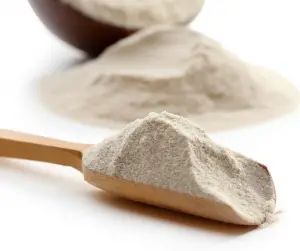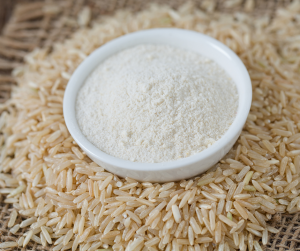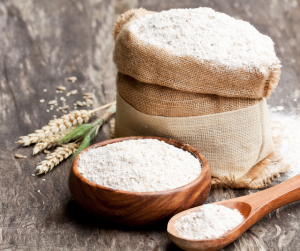Flour is one of the most basic ingredients that should be in a prepper’s pantry because it has been a big part of our diet for a long time and it can be used in so many ways.

Adding just a little bit of flour and water together will create a dough that can be cooked into an incredibly simple bread. Of course, the list of more complex recipes using flour is much too long to list here, suffice to say its versatility is vast.
But is all flour the same? How long does it last? And how should it be stored? Well, those are just a few of the questions that are answered in this article about flour and prepping.
SKIP AHEAD
Whole Grains vs Refined Flour for Stockpiling
There are two very broad types of flour that a person can stockpile; whole grains or refined flour which has already been processed.
Whole Grains
Whole grains may give one of the healthiest options when choosing flour, but it is not without its pitfalls.
Storing whole grains properly will give a shelf life of between 6 months on the shelf to a year if refrigerated or frozen.
The biggest two negatives about using whole grains are the storage space and equipment needed. Storing whole grains is going to take up more space while producing less flour than if flour itself is stored.
Secondly, a way to process or mill the grains will be required. This can be done with an electric grinder, but that piece of equipment is dependent on a power source. A manual grinder is another option, but this will take time, effort and the grinder may be heavy or bulky to transport.
Refined Flour
Overall, refined flour is going to be the best option to store for most people.
Since it has already been processed it requires no additional equipment on the preppers part other than supplies needed for storing it.
It will also be more affordable, accessible, easier to store, easier to transport, and ready to go when a person wants to use it.
The cons of processed flour are twofold.
Firstly, if it is not stored properly it will deteriorate much quicker than whole grains.
Secondly, many flours are subjected to certain processes or have additives in them that may not be ideal in some diets. Additionally, some additives can shorten the shelf life of the product they are in.
Best Flour for Survival: Top 3 Picks
All-Purpose Flour
This is the most sold flour in the U.S. as well as many other nations.
It is milled from wheat grains, put through a refining process, and then bleached. Flour is bleached as a way of causing it to age faster. Aged flour produces a finer, softer grain.
The flour is often used in a wide array of cooking applications that include making bread, cakes, and fried foods. It can also be used to thicken gravies, soups, and stews.
All-purpose flour can last over six months when stored on the counter or shelf. Refrigerating it will lengthen that to one year and keeping it in the freezer can make it last up to two years.
Rice Flour
This type of flour is milled from rice rather than wheat. It can be processed from either white or brown rice. Brown rice may be more nutritious but due to the extra oils present in it, its shelf life will be shorter than white rice.
It is often used to make noodles as well as a thickening agent in liquid dishes.
White rice flour may store for decades if stored properly but brown rice flour may only last around 4 months on the shelf.
Whole Wheat Flour
Whole wheat flour is made by milling the entire wheat grain, rather than just a portion of it.
It is generally more nutritious and contains more fiber than its all-purpose counterpart, but it will not last as long on the shelf.
One to three months is the lifespan of whole wheat flour when stored on the counter but this can be doubled when the flour is stored in the freezer.
Open Questions
Q: How should flour be stored?
A: The two main enemies of flour are air and moisture. For this reason, flour should be stored in airtight, waterproof containers with a couple of oxygen absorbers thrown in.
Flour can be stored in bags, pouches, or right into a bucket. If the flour is packaged in a soft container like mylar or resealable bag it is best to place them into a hard, food-grade container with a lid for added protection.
When storing in large buckets, it is helpful to separate the flour into manageable amounts that are placed in mylar, vacuumed sealed, or resealable bags.
Once the flour is securely packed away, the container should be stored in a cool, dry. This will help to prolong its shelf life.
Q: How much flour should a person have?
A: A good rule of thumb is to store 50lbs of flour per person for a one-year supply. So, a family of four should have approximately 200lbs of flour in their supplies.
That may seem like a lot considering that most people normally only keep a small bag of it on their shelf. But from cookies, crackers, bread, baked goods, to cereals, flour is in a lot of food that we consume.
Q: How long does flour last?
A: This is a bit tricky as the shelf life of flour depends on the kind you want to store. There are also widely different opinions on how long it lasts.
Flours that have color to them generally last the shortest amount of time because they have oils or other additives in them that can cause the flour to go bad.
But there does seem to be a consensus on white flour and rice flour lasting the longest. These two seem to last almost indefinitely when safely stored.
Q: How can you tell if the flour has gone bad?
A: Like most foods that go bad, the flour will have a smell. When flour is good it may not smell like anything or it will smell how that brand of flour normally smells. If it smells not right in any other way, it probably is no longer good.
Also, flour should not be discolored in any way from its original color. That means white all-purpose flour should always be white.
Additionally, flour that has come into contact with water will clump up and may become hard. It is always best to be safe than sorry, so if any of the above characteristics are observed throw the flour away.
Q: Why do some people put their flour in the freezer right after they buy it?
A: There is a possibility that flour can contain eggs laid by certain insects. Placing flour in the freezer for up to a week will help in killing any eggs that may be present.
Wrap Up
The younger version of me used to think flour was only used for making bread. It didn’t take long, however, for me to learn that it is used in a lot of recipes and in the food that we buy.
After reading this article, go look through your pantry and read some of the ingredient labels on the food you have. I think you will be surprised at just how much flour there is in our diet.
Whether you are making bread, cookies, crackers, cereals, gravies, fried chicken, or using it as a thickening agent in soups and stews, flour is one item you will want to make sure you have plenty of!
Thanks for reading and stay prepared!
Sound off in the comment section below and let us know what your favorite flour is and how you like to store it.





